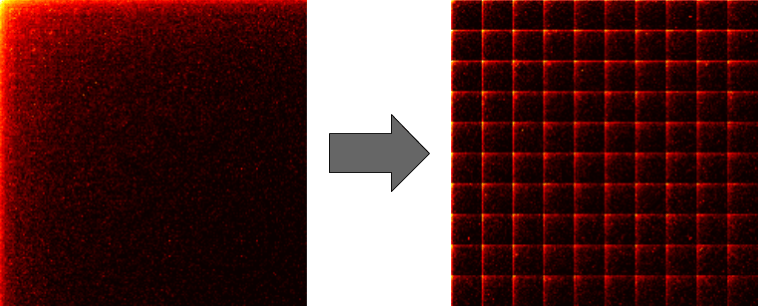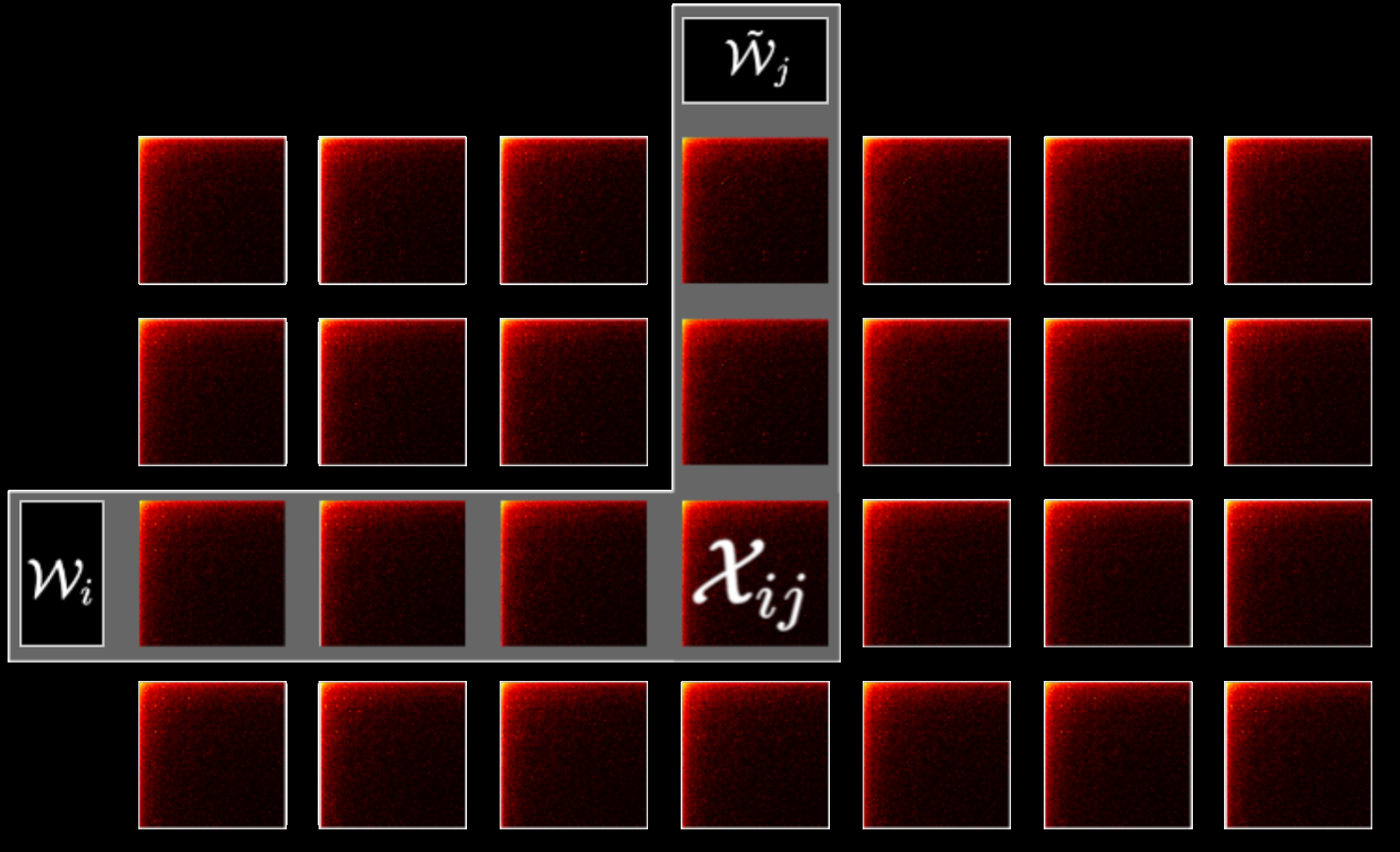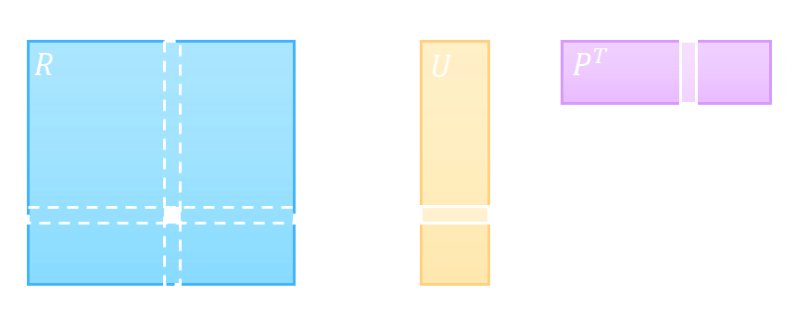Context — word
"Words are just words."
Window size is 1.
Konstantin Slavnov, source{d}.
Konstantin Slavnov, source{d}
[ 1, 1][ 0,-1][ 0, 1][-1, 1][ 2, 0]
from sklearn.feature_extraction import FeatureHasher
fruits = ["cherry", "peach", "apple", "grapes", "strawberry"]
hasher = FeatureHasher(n_features=2, input_type="string")
hasher.transform(fruits)
250150100250150100tensorflow fa-floppy-oat unaligned vector ttypes types const unaligned vec int unaligned vector ttypes types int const unaligned vec example statistics norm normalized squared regularizations regularizations status initialize construction kernel opkernel context error iferror return tfreturn context attr get symmetric error iferror return tfreturn context attr get symmetric shrinkage symmetric symmetric status shrink weight shrinked std max std abs weight shrinkage shrinked std copysign shrinked weight eigen tensor eigen major row eigen shrink eigen tensor eigen major row weights weights sign weights abs weights constant shrinkage cwise max weights constant shrinkage cwise max weights constant symmetric symmetric symmetric symmetric shrinkage and assign copy disallow tfdisallow regularizations model weights example example statistics and compute example norm weighted wxand num partitions model weights model weights regularizations regularization example label example label example weight example weight norm squared norm squared features sparse std ptr unique int unaligned vector indices std ptr unique float unaligned vector values std vector features sparse features sparse dense vector eigen map tensor eigen tensor eigen major row row eigen map tensor eigen tensor eigen major row data matrix data index row data matrix dimension data matrix dimension ttypes types const matrix data matrix int index row std vector std ptr unique dense vector dense vectors example label example weight norm squared examples model weights model weights model weights delta update weights eigen device pool thread device example example bounded delta dual normalized sparse weights size example features sparse features sparse example features sparse feature weights feature weights sparse weights int features sparse indices size feature value features sparse values features sparse values feature weights deltas features sparse indices feature value bounded delta dual normalized dense weights size example dense vector dense vector example dense vectors ttypes types vec deltas dense weights deltas deltas device device deltas dense vector row deltas constant bounded delta dual normalized status initialize context kernel opkernel context input list opinput inputs sparse weights error iferror return tfreturn context input list inputs sparse weights input list opinput dense inputs weights error iferror return tfreturn context input list dense inputs weights list opoutput output outputs sparse weights error iferror return tfreturn context list output outputs sparse weights list opoutput output dense outputs weights error iferror return tfreturn context list output dense outputs weights intialize weights input list opinput inputs weight list opoutput output outputs weight std vector feature weights feature weights inputs weight size tensor delta outputs weight allocate inputs weight shape delta deltas delta flat deltas set zero feature weights back emplace feature weights inputs weight flat deltas intialize weights inputs sparse weights outputs sparse weights sparse weights intialize weights dense inputs weights dense outputs weights dense weights status feature weights ttypes types vec nominals ttypes types vec deltas std vector feature weights sparse weights std vector feature weights dense weights example and assign copy disallow tfdisallow model weights example statistics example and compute example norm weighted wxand num partitions model weights model weights regularizations regularization example statistics result result norm normalized squared norm squared regularization symmetric features sparse size example features sparse features sparse features sparse model weights feature weights sparse weights model weights sparse weights int features sparse indices size int feature index features sparse indices feature value features sparse values features sparse values feature weight sparse weights nominals feature index sparse weights deltas feature index num partitions result feature value regularization shrink feature weight dense vectors size example dense vector dense vector dense vectors model weights feature weights dense weights model weights dense weights eigen tensor eigen major row feature weights dense weights nominals dense weights deltas dense weights deltas constant num partitions eigen tensor eigen major row prediction dense vector row regularization eigen shrink feature weights sum result prediction result examples examples example example example index examples example index examples num examples size features num features num status initialize context kernel opkernel context features num sparse features num sparse values with dense features num features num features num sparse dense features num input list opinput example indices inputs sparse error iferror return tfreturn context input list example indices inputs sparse input list opinput feature indices inputs sparse error iferror return tfreturn context input list feature indices inputs sparse input list opinput feature inputs sparse values features num sparse values with error iferror return tfreturn context input list feature inputs sparse values tensor example weights error iferror return tfreturn context input example weights example weights example weights flat examples num example weights size tensor example labels error iferror return tfreturn context input example labels example labels example labels flat input list opinput dense features inputs error iferror return tfreturn context input list dense features inputs examples clear examples
\( \begin{split} \texttt{"apple"} \Leftrightarrow & \; V_1 \\ \\ \texttt{"peach"} \Leftrightarrow & \; V_2 \\ \\ \texttt{"cat"} \Leftrightarrow & \; V_3 \\ \\ \mathrm{similarity}(V_1, V_2) < & \; \mathrm{similarity}(V_1, V_3) \end{split} \)
\( \begin{split} \texttt{"apple"} \Leftrightarrow & \; V_1 \\ \\ \texttt{"peach"} \Leftrightarrow & \; V_2 \\ \\ \texttt{"cat"} \Leftrightarrow & \; V_3 \\ \\ \mathrm{similarity}(V_1, V_2) \sim & \; {V_1}^\top V_2 \end{split} \)
Pointwise mutual information:
\(\mathrm{PMI} (x;y) \equiv \log {\dfrac {p(x,\,y)}{p(x)\,p(y)}}.\)Pointwise mutual information:
\( \mathrm{PMI} (x;y) \equiv \log {\dfrac {p(x,\,y)}{p(x)\,p(y)}}. \\[20pt] x = \mathrm{words} \quad y = \mathrm{words} \\ \dfrac {p(\mathrm{words},\, \mathrm{words})}{p(\mathrm{words})\,p(\mathrm{words})} = \dfrac {0}{1/3 \,\cdot\, 1/3} = 0. \\ \)Pointwise mutual information:
\( \mathrm{PMI} (x;y) \equiv \log {\dfrac {p(x,\,y)}{p(x)\,p(y)}}. \\[20pt] x = \mathrm{words} \quad y = \mathrm{just} \\ \dfrac {p(\mathrm{words},\, \mathrm{just})}{p(\mathrm{words})\,p(\mathrm{just})} = \dfrac {1/6}{1/3 \,\cdot\, 1/3} = 1.5 \\ \)

class Database:def connect(self, user, password, host, port):self._tcp_socket_connect(host, port)try:self._authenticate(user, password)except AuthenticationError as e:self.socket.close()raise e from None
_tcp_socket_connect ⇒ [tcp, socket, connect]
AuthenticationError ⇒ [authentication, error]
authentication, authenticate ⇒ authenticate
class Database:def connect(self, user, password, host, port):self._tcp_socket_connect(host, port)try:self._authenticate(user, password)except AuthenticationError as e:self.socket.close()raise e from None
database, connect2, user2, password2, host2, port2, tcp, socket2, authenticate2, error, close
class Database:def connect(self, user, password, host, port):self._tcp_socket_connect(host, port)try:self._authenticate(user, password)except AuthenticationError as e:self.socket.close()raise e from None
connect2, user2, password2, host2, port2, tcp, socket2, authenticate2, error, close
class Database:def connect(self, user, password, host, port):self._tcp_socket_connect(host, port)try:self._authenticate(user, password)except AuthenticationError as e:self.socket.close()raise e from None
connect, user, password, host, port
class Database:def connect(self, user, password, host, port):self._tcp_socket_connect(host, port)try:self._authenticate(user, password)except AuthenticationError as e:self.socket.close()raise e from None
tcp, socket, connect, host, port
class Database:def connect(self, user, password, host, port):self._tcp_socket_connect(host, port)try:self._authenticate(user, password)except AuthenticationError as e:self.socket.close()raise e from None
authenticate2, user, password, error, socket, close
class Database:def connect(self, user, password, host, port):self._tcp_socket_connect(host, port)try:self._authenticate(user, password)except AuthenticationError as e:self.socket.close()raise e from None
authenticate, user, password
class Database:def connect(self, user, password, host, port):self._tcp_socket_connect(host, port)try:self._authenticate(user, password)except AuthenticationError as e:self.socket.close()raise e from None
authenticate, error, socket, close
class Database:def connect(self, user, password, host, port):self._tcp_socket_connect(host, port)try:self._authenticate(user, password)except AuthenticationError as e:self.socket.close()raise e from None
authenticate, error
class Database:def connect(self, user, password, host, port):self._tcp_socket_connect(host, port)try:self._authenticate(user, password)except AuthenticationError as e:self.socket.close()raise e from None
socket, close
\(V(\mathrm{bug})\) \(-\) \(V(\mathrm{test})\) \(+\) \(V(\mathrm{expect})\) \(\approx\) \(V(\mathrm{suppress})\)
\(V(\mathrm{database})\) \(-\) \(V(\mathrm{query})\) \(+\) \(V(\mathrm{tune})\) \(\approx\) \(V(\mathrm{settings})\)
\(V(\mathrm{send})\) \(-\) \(V(\mathrm{receive})\) \(+\) \(V(\mathrm{pop})\) \(\approx\) \(V(\mathrm{push})\)
$ python3 -m sourced.ml repo2coocc ...
$ python3 -m sourced.ml id2vec-preproc ...
$ python3 -m sourced.ml id2vec-train ...
import numpy as np
seed = 42
np.random.seed(seed)
print(np.random.randint(10))
from sklearn.cluster import KMeans
X = np.array([[1, 2], [1, 4]])
kmeans = KMeans(2).fit(X)
print(kmeans.labels_)
import numpy as np
seed = 42
np.random.seed(seed)
print(np.random.randint(10))
from sklearn.cluster import KMeans
X = np.array([[1, 2], [1, 4]])
kmeans = KMeans(2).fit(X)
print(kmeans.labels_)
import numpy as np
seed = 42
np.random.seed(seed)
print(np.random.randint(10))
from sklearn.cluster import KMeans
X = np.array([[1, 2], [1, 4]])
kmeans = KMeans(2).fit(X)
print(kmeans.labels_)
import numpy as np
seed = 42
np.random.seed(seed)
print(np.random.randint(10))
from sklearn.cluster import KMeans
X = np.array([[1, 2], [1, 4]])
kmeans = KMeans(2).fit(X)
print(kmeans.labels_)
import numpy as np
seed = 42
np.random.seed(seed)
print(np.random.randint(10))
from sklearn.cluster import KMeans
X = np.array([[1, 2], [1, 4]])
kmeans = KMeans(2).fit(X)
print(kmeans.labels_)
import numpy as np
seed = 42
np.random.seed(seed)
print(np.random.randint(10))
from sklearn.cluster import KMeans
X = np.array([[1, 2], [1, 4]])
kmeans = KMeans(2).fit(X)
print(kmeans.labels_)
import numpy as np
seed = 42
np.random.seed(seed)
print(np.random.randint(10))
from sklearn.cluster import KMeans
X = np.array([[1, 2], [1, 4]])
kmeans = KMeans(2).fit(X)
print(kmeans.labels_)
import matplotlib.pyplot as plt
import seaborn as sns; sns.set()
import numpy as np
rng = np.random.RandomState(1)
x = 10 * rng.rand(50)
y = 2 * x - 5 + rng.randn(50)
plt.scatter(x, y);
from sklearn.linear_model import LinearRegression
model = LinearRegression(fit_intercept=True)
model.fit(x[:, np.newaxis], y)
xfit = np.linspace(0, 10, 1000)
yfit = model.predict(xfit[:, np.newaxis])
plt.scatter(x, y)
plt.plot(xfit, yfit);
print("Model slope: ", model.coef_[0])
print("Model intercept:", model.intercept_)
rng = np.random.RandomState(1)
X = 10 * rng.rand(100, 3)
y = 0.5 + np.dot(X, [1.5, -2., 1.])
model.fit(X, y)
print(model.intercept_)
print(model.coef_)
from sklearn.preprocessing import PolynomialFeatures
x = np.array([2, 3, 4])
poly = PolynomialFeatures(3, include_bias=False)
poly.fit_transform(x[:, None])
from sklearn.pipeline import make_pipeline
poly_model = make_pipeline(PolynomialFeatures(7),
LinearRegression())
rng = np.random.RandomState(1)
x = 10 * rng.rand(50)
y = np.sin(x) + 0.1 * rng.randn(50)
poly_model.fit(x[:, np.newaxis], y)
yfit = poly_model.predict(xfit[:, np.newaxis])
plt.scatter(x, y)
plt.plot(xfit, yfit);
from sklearn.base import BaseEstimator, TransformerMixin
class GaussianFeatures(BaseEstimator, TransformerMixin):
"""Uniformly spaced Gaussian features for one-dimensional input"""
def __init__(self, N, width_factor=2.0):
self.N = N
self.width_factor = width_factor
@staticmethod
def _gauss_basis(x, y, width, axis=None):
arg = (x - y) / width
return np.exp(-0.5 * np.sum(arg ** 2, axis))
def fit(self, X, y=None):
self.centers_ = np.linspace(X.min(), X.max(), self.N)
self.width_ = self.width_factor * (self.centers_[1] - self.centers_[0])
return self
def transform(self, X):
return self._gauss_basis(X[:, :, np.newaxis], self.centers_,
self.width_, axis=1)
gauss_model = make_pipeline(GaussianFeatures(20),
LinearRegression())
gauss_model.fit(x[:, np.newaxis], y)
yfit = gauss_model.predict(xfit[:, np.newaxis])
plt.scatter(x, y)
plt.plot(xfit, yfit)
plt.xlim(0, 10);
model = make_pipeline(GaussianFeatures(30),
LinearRegression())
model.fit(x[:, np.newaxis], y)
plt.scatter(x, y)
plt.plot(xfit, model.predict(xfit[:, np.newaxis]))
plt.xlim(0, 10)
plt.ylim(-1.5, 1.5);
def basis_plot(model, title=None):
fig, ax = plt.subplots(2, sharex=True)
model.fit(x[:, np.newaxis], y)
ax[0].scatter(x, y)
ax[0].plot(xfit, model.predict(xfit[:, np.newaxis]))
ax[0].set(xlabel='x', ylabel='y', ylim=(-1.5, 1.5))
if title:
ax[0].set_title(title)
ax[1].plot(model.steps[0][1].centers_,
model.steps[1][1].coef_)
ax[1].set(xlabel='basis location',
ylabel='coefficient',
xlim=(0, 10))
model = make_pipeline(GaussianFeatures(30), LinearRegression())
basis_plot(model)
from sklearn.linear_model import Ridge
model = make_pipeline(GaussianFeatures(30), Ridge(alpha=0.1))
basis_plot(model, title='Ridge Regression')
from sklearn.linear_model import Lasso
model = make_pipeline(GaussianFeatures(30), Lasso(alpha=0.001))
basis_plot(model, title='Lasso Regression')
import pandas as pd
counts = pd.read_csv('FremontBridge.csv', index_col='Date', parse_dates=True)
weather = pd.read_csv('data/BicycleWeather.csv', index_col='DATE', parse_dates=True)
daily = counts.resample('d').sum()
daily['Total'] = daily.sum(axis=1)
daily = daily[['Total']]
days = ['Mon', 'Tue', 'Wed', 'Thu', 'Fri', 'Sat', 'Sun']
for i in range(7):
daily[days[i]] = (daily.index.dayofweek == i).astype(float)
from pandas.tseries.holiday import USFederalHolidayCalendar
cal = USFederalHolidayCalendar()
holidays = cal.holidays('2012', '2016')
daily = daily.join(pd.Series(1, index=holidays, name='holiday'))
daily['holiday'].fillna(0, inplace=True)
def hours_of_daylight(date, axis=23.44, latitude=47.61):
"""Compute the hours of daylight for the given date"""
days = (date - pd.datetime(2000, 12, 21)).days
m = (1. - np.tan(np.radians(latitude))
* np.tan(np.radians(axis) * np.cos(days * 2 * np.pi / 365.25)))
return 24. * np.degrees(np.arccos(1 - np.clip(m, 0, 2))) / 180.
daily['daylight_hrs'] = list(map(hours_of_daylight, daily.index))
daily[['daylight_hrs']].plot()
plt.ylim(8, 17)
weather['TMIN'] /= 10
weather['TMAX'] /= 10
weather['Temp (C)'] = 0.5 * (weather['TMIN'] + weather['TMAX'])
weather['PRCP'] /= 254
weather['dry day'] = (weather['PRCP'] == 0).astype(int)
daily = daily.join(weather[['PRCP', 'Temp (C)', 'dry day']])
daily['annual'] = (daily.index - daily.index[0]).days / 365.
daily.head()
daily.dropna(axis=0, how='any', inplace=True)
column_names = ['Mon', 'Tue', 'Wed', 'Thu', 'Fri', 'Sat', 'Sun', 'holiday',
'daylight_hrs', 'PRCP', 'dry day', 'Temp (C)', 'annual']
X = daily[column_names]
y = daily['Total']
model = LinearRegression(fit_intercept=False)
model.fit(X, y)
daily['predicted'] = model.predict(X)
daily[['Total', 'predicted']].plot(alpha=0.5);
params = pd.Series(model.coef_, index=X.columns)
params
from sklearn.utils import resample
np.random.seed(1)
err = np.std([model.fit(*resample(X, y)).coef_
for i in range(1000)], 0)
print(pd.DataFrame({'effect': params.round(0),
'error': err.round(0)}))
import matplotlib.pyplot as plt
import seaborn as sns; sns.set()
import numpy as np
rng = np.random.RandomState(1)
x = 10 * rng.rand(50)
y = 2 * x - 5 + rng.randn(50)
plt.scatter(x, y);
from sklearn.linear_model import LinearRegression
model = LinearRegression(fit_intercept=True)
model.fit(x[:, np.newaxis], y)
xfit = np.linspace(0, 10, 1000)
yfit = model.predict(xfit[:, np.newaxis])
plt.scatter(x, y)
plt.plot(xfit, yfit);
print("Model slope: ", model.coef_[0])
print("Model intercept:", model.intercept_)
rng = np.random.RandomState(1)
X = 10 * rng.rand(100, 3)
y = 0.5 + np.dot(X, [1.5, -2., 1.])
model.fit(X, y)
print(model.intercept_)
print(model.coef_)
from sklearn.preprocessing import PolynomialFeatures
x = np.array([2, 3, 4])
poly = PolynomialFeatures(3, include_bias=False)
poly.fit_transform(x[:, None])
from sklearn.pipeline import make_pipeline
poly_model = make_pipeline(PolynomialFeatures(7),
LinearRegression())
rng = np.random.RandomState(1)
x = 10 * rng.rand(50)
y = np.sin(x) + 0.1 * rng.randn(50)
poly_model.fit(x[:, np.newaxis], y)
yfit = poly_model.predict(xfit[:, np.newaxis])
plt.scatter(x, y)
plt.plot(xfit, yfit);
from sklearn.base import BaseEstimator, TransformerMixin
class GaussianFeatures(BaseEstimator, TransformerMixin):
"""Uniformly spaced Gaussian features for one-dimensional input"""
def __init__(self, N, width_factor=2.0):
self.N = N
self.width_factor = width_factor
@staticmethod
def _gauss_basis(x, y, width, axis=None):
arg = (x - y) / width
return np.exp(-0.5 * np.sum(arg ** 2, axis))
def fit(self, X, y=None):
self.centers_ = np.linspace(X.min(), X.max(), self.N)
self.width_ = self.width_factor * (self.centers_[1] - self.centers_[0])
return self
def transform(self, X):
return self._gauss_basis(X[:, :, np.newaxis], self.centers_,
self.width_, axis=1)
gauss_model = make_pipeline(GaussianFeatures(20),
LinearRegression())
gauss_model.fit(x[:, np.newaxis], y)
yfit = gauss_model.predict(xfit[:, np.newaxis])
plt.scatter(x, y)
plt.plot(xfit, yfit)
plt.xlim(0, 10);
model = make_pipeline(GaussianFeatures(30),
LinearRegression())
model.fit(x[:, np.newaxis], y)
plt.scatter(x, y)
plt.plot(xfit, model.predict(xfit[:, np.newaxis]))
plt.xlim(0, 10)
plt.ylim(-1.5, 1.5);
def basis_plot(model, title=None):
fig, ax = plt.subplots(2, sharex=True)
model.fit(x[:, np.newaxis], y)
ax[0].scatter(x, y)
ax[0].plot(xfit, model.predict(xfit[:, np.newaxis]))
ax[0].set(xlabel='x', ylabel='y', ylim=(-1.5, 1.5))
if title:
ax[0].set_title(title)
ax[1].plot(model.steps[0][1].centers_,
model.steps[1][1].coef_)
ax[1].set(xlabel='basis location',
ylabel='coefficient',
xlim=(0, 10))
model = make_pipeline(GaussianFeatures(30), LinearRegression())
basis_plot(model)
from sklearn.linear_model import Ridge
model = make_pipeline(GaussianFeatures(30), Ridge(alpha=0.1))
basis_plot(model, title='Ridge Regression')
from sklearn.linear_model import Lasso
model = make_pipeline(GaussianFeatures(30), Lasso(alpha=0.001))
basis_plot(model, title='Lasso Regression')
import pandas as pd
counts = pd.read_csv('FremontBridge.csv', index_col='Date', parse_dates=True)
weather = pd.read_csv('data/BicycleWeather.csv', index_col='DATE', parse_dates=True)
daily = counts.resample('d').sum()
daily['Total'] = daily.sum(axis=1)
daily = daily[['Total']]
days = ['Mon', 'Tue', 'Wed', 'Thu', 'Fri', 'Sat', 'Sun']
for i in range(7):
daily[days[i]] = (daily.index.dayofweek == i).astype(float)
from pandas.tseries.holiday import USFederalHolidayCalendar
cal = USFederalHolidayCalendar()
holidays = cal.holidays('2012', '2016')
daily = daily.join(pd.Series(1, index=holidays, name='holiday'))
daily['holiday'].fillna(0, inplace=True)
def hours_of_daylight(date, axis=23.44, latitude=47.61):
"""Compute the hours of daylight for the given date"""
days = (date - pd.datetime(2000, 12, 21)).days
m = (1. - np.tan(np.radians(latitude))
* np.tan(np.radians(axis) * np.cos(days * 2 * np.pi / 365.25)))
return 24. * np.degrees(np.arccos(1 - np.clip(m, 0, 2))) / 180.
daily['daylight_hrs'] = list(map(hours_of_daylight, daily.index))
daily[['daylight_hrs']].plot()
plt.ylim(8, 17)
weather['TMIN'] /= 10
weather['TMAX'] /= 10
weather['Temp (C)'] = 0.5 * (weather['TMIN'] + weather['TMAX'])
weather['PRCP'] /= 254
weather['dry day'] = (weather['PRCP'] == 0).astype(int)
daily = daily.join(weather[['PRCP', 'Temp (C)', 'dry day']])
daily['annual'] = (daily.index - daily.index[0]).days / 365.
daily.head()
daily.dropna(axis=0, how='any', inplace=True)
column_names = ['Mon', 'Tue', 'Wed', 'Thu', 'Fri', 'Sat', 'Sun', 'holiday',
'daylight_hrs', 'PRCP', 'dry day', 'Temp (C)', 'annual']
X = daily[column_names]
y = daily['Total']
model = LinearRegression(fit_intercept=False)
model.fit(X, y)
daily['predicted'] = model.predict(X)
daily[['Total', 'predicted']].plot(alpha=0.5);
params = pd.Series(model.coef_, index=X.columns)
params
from sklearn.utils import resample
np.random.seed(1)
err = np.std([model.fit(*resample(X, y)).coef_
for i in range(1000)], 0)
print(pd.DataFrame({'effect': params.round(0),
'error': err.round(0)}))
